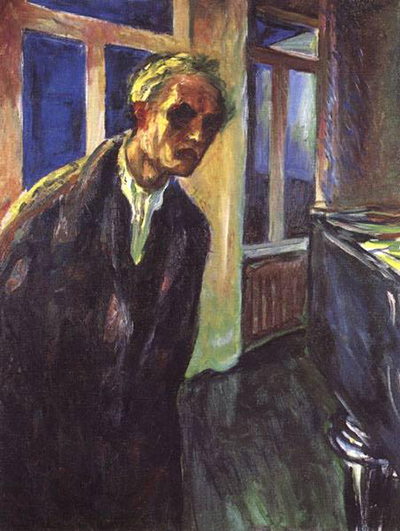Edvard Munch had a great understanding of expressionism in painting. In a self-portrait, The Night Wanderer, the artist paints himself as an insomniac figure wandering around a darkened house.
From the portrait, a viewer can identify the house's windows boarded by some wood. Edvard is dressed in a black coat and a seemingly white shirt. His face looks a little blurred, and the eyes seem darkened. His hair stands out as it is brown. He painted this oil and canvas art between 1923 and 1924. During this time, Edvard was stabilising and taking care of his family. He had just recovered from a few things, such as alcoholism and binge drinking. Looking further into the portrait, one can only know it's a person by the facial and hands blur. The rooms behind seem illuminated, but his eyes appear dark and deep. They are not identifiable in the portrait.
In the portrait, the artist hid his hands in his pocket or behind his back, and he seems to lean forward as if checking for something from the entrance of the room. The portrait also shows no time or place that could be occurring. Interpreters thought of it as an anxiety portrait. Deeper into the image, Edvard is wearing a long gown or a warm coat. He has just arrived and wants to get into the premise or is leaving the premise. A viewer cannot know whether he is at home or in another place or area. From the look of things, the place is not safe. He seems torn in-between options, especially on whether he should get into the premise or leave. The intentions of this portrait are not clear; it only shows indecisiveness and fear towards his life at the time.
The Norwegian artist is widely renowned for his expressionism prowess. At a young age, he suffered several illnesses that barred him from going to school in winter. He, therefore, had a significant amount of time and used it to paint with watercolours. The self-portrait is thought to have been taken in his villa. In 1916, the artist acquired a villa which is almost ten years before this painting. Munch had just been treated for a nervous breakdown; he had survived the Spanish flu and was plating vegetables and fruits near his newly acquired house. Generally, it was not the best time of his life. Looking at his end years, Munch concentrated on self-portraits as a way to explain his personality and feelings. He showed everything he went through oil and canvas paintings.




